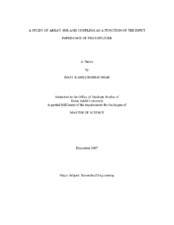| dc.description.abstract | Much of the current research in magnetic resonance engineering focuses on
reducing the acquisition time for obtaining an image while simultaneously maximizing
the Signal to Noise ratio (SNR) of the image. It is known that improvement in imaging
time or resolution is obtained at the cost of SNR. Therefore wherever possible, RF coil
engineers design the coil in such a manner so as to maximize SNR for that coil design. In
one such design consideration, most coil designers prefer placing low impedance preamplifiers
near the coil. The further the pre-amplifiers are from the coil, the greater will
be the signal loss due to transmission and higher will be its input impedance as perceived
at the coil which would degrade inter-coil isolation. Owing to the current trend of using
increasing number of receiver channels (32, 64 or 128) for parallel imaging, placing the
preamplifiers near the coil would greatly complicate the coil construction.
The primary objective of this research was to find the relation between SNR and
referred preamp impedance and whether preamps need to be placed on the coil, or if they
can be placed outside the magnet at the end of a transmission line which would simplify
the construction of large count array. In addition, SNR was studied as a function of coil
design parameters - coil loading, array coil separation, and system frequency. Both
theoretical and experimental methods were used to undertake this investigation. A
popular electromagnetic modeling technique, finite difference time domain (FDTD), was used to model SNR in arrays of two 3 inch loop coils at 3T and 1.5T. Results were also
verified through bench measurement at 3T and 1.5T and by evaluating SNR. To verify
the robustness of our results and to assess the possibility of using low cost standard 50
ohm preamps, we carried out additional bench measurements at 4.7T. Results
demonstrated that preamplifier placement is critical at low field strength. At higher field
strength, SNR degradation due to preamplifier placement was less owing to heavier coil
loading. | en |


